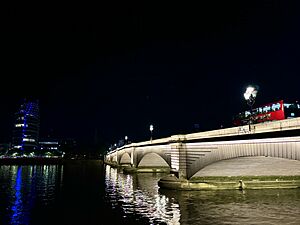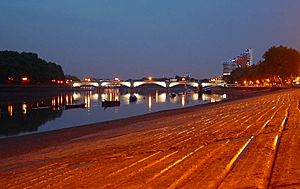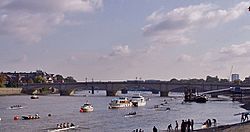Putney facts for kids
Quick facts for kids Putney |
|
|---|---|
 Putney Bridge at night |
|
| Population | 77,140 (2011 census) |
| OS grid reference | TQ235755 |
| London borough | |
| Ceremonial county | Greater London |
| Region | |
| Country | England |
| Sovereign state | United Kingdom |
| Post town | LONDON |
| Postcode district | SW15 |
| Dialling code | 020 |
| Police | Metropolitan |
| Fire | London |
| Ambulance | London |
| EU Parliament | London |
| UK Parliament |
|
| London Assembly |
|
Putney (/ˈpʌtni/) is a lively area in south-west London, England. It's part of the London Borough of Wandsworth and is about 5 miles (8 km) southwest of Charing Cross. Putney is known as one of the 35 main centres in Greater London.
Contents
Putney's Past: A Look Back in Time
Putney is a very old area. It used to be a parish in the county of Surrey. Over time, its size changed, and nearby Roehampton became its own separate area.
In 1889, Putney became part of the County of London. Then, in 1965, it joined the London Borough of Wandsworth in Greater London.
The church in Putney, St Mary the Virgin, has a long history. It was rebuilt several times over the centuries. In the past, a special school for 20 boys, sons of watermen, was started here in 1684. There was also a charitable home for 12 men and women.
Putney is famous for being the birthplace of some important people:
- Thomas Cromwell (born around 1485), who was a chief minister for Henry VIII.
- Edward Gibbon (born 1737), who wrote a famous book called Decline and Fall of the Roman Empire.
- Clement Attlee (born 1883), who was the Prime Minister of the United Kingdom from 1945 to 1951.
In the 1840s, Putney was still a village with some woods and farms. It was connected to Fulham by a wooden bridge.
Crossing the River Thames
The name Putney comes from an old Anglo-Saxon name, Puttan hythe, which means "Putta's landing place." In old records from 1086, it was noted that Putney made money from a ferry or market toll.
The ferry was used by important people, including King Edward I in the late 1200s.
A famous story tells of Cardinal Wolsey crossing at Putney in 1529. He had fallen out of favour with King Henry VIII. As he rode up Putney Hill, a royal messenger brought him good news from the King. Wolsey was so happy that he knelt down to thank God and the King right there.
The first bridge between Fulham and Putney was built during the English Civil War in 1642. It was a temporary bridge made of boats.
The first permanent bridge was finished in 1729. It was the second bridge built across the River Thames in London, after London Bridge.
There's a story that Sir Robert Walpole, a powerful politician, was once delayed by the ferry. He vowed that a bridge would replace it. The Prince of Wales also wanted a bridge because the ferry often caused delays when he returned from hunting. This first bridge was made of wood and lasted 150 years. In 1886, it was replaced by the stone bridge you see today.
St Mary's Church and the Putney Debates
St Mary the Virgin is famous for the Putney Debates in 1647. This happened near the end of the English Civil War. Soldiers in the New Model Army were worried that a new dictatorship might replace the monarchy.
A group called the Levellers wanted a fair, democratic state. They suggested ideas like:
- English citizens having more power.
- Parliamentary seats based on population, not just property.
- Freedom of religion.
- Equality before the law.
- Yearly elections for Parliament.
These ideas were very important and even inspired parts of the United States Declaration of Independence. However, Oliver Cromwell later had the Leveller leaders executed.
The famous diarist Samuel Pepys visited St. Mary's Church in 1667. He wrote about seeing school girls there and how his hat fell through a hole under the pulpit!
Open Spaces and Fresh Air
For hundreds of years, Londoners came to Putney to relax and enjoy the fresh air. They played games like bowling. In 1679, John Locke wrote that people of high status often came to Putney to play bowling.
Queen Elizabeth I often visited Putney between 1579 and 1603. She would sometimes stay for two or three days.
Putney Heath: A Place of History and Nature
King Charles II and George III both reviewed their armies on Putney Heath. Charles II and his brother, the Duke of York, also used to race horses here.
A stone obelisk was built on Putney Heath in 1770. It marked 110 years since the Great Fire of London and celebrated new fireproof inventions by David Hartley (the Younger). This obelisk is still standing today and is a Grade II listed building.
Many duels (fights between two people to settle an argument) happened on Putney Heath. In 1798, William Pitt the Younger, who was the Prime Minister, fought a duel here. He lived in Bowling-Green House on the heath, which was once a famous place for entertainment. Pitt died in this house in 1806.
Putney Heath is about 400 acres (160 hectares) in size. From 1796 to 1816, it had a signal station that sent messages from London to naval ships in Portsmouth in just 15 minutes!
For many years, Putney Heath was a place where highwaymen (robbers on roads) would hide. In 1795, a famous highwayman named Jeremiah Abershaw was caught at the Green Man pub on the heath. After he was executed, his body was hung on the heath as a warning.
Today, the village green on Putney Heath is used by Roehampton Cricket Club, one of London's oldest cricket teams. They have played here since 1859.
Putney's Local Feel
In 2005, a study looked at 27 shopping streets in London. Putney was ranked as one of the most "cloned," meaning it had many of the same shops as other areas, with less unique local character.
Who Lives in Putney?
The 2011 census showed that many people in Putney work in professional jobs like doctors and lawyers. About 46% of residents are in "managerial, administrative & professional" roles.
Most residents (81%) are white, with 8% Asian and 5% black. About 65% of the people were born in the UK. Christianity is the most common religion (56%), but many (27%) say they have no religion. Putney also has a high number of people from Australia, New Zealand, and South Africa.
Rowing and the Famous Boat Race
Since the mid-1800s, Putney has been a very important place for rowing. There are two main reasons for this: 1. Cleaner River: As more steam boats and sewage made the Thames in central London unpleasant, Putney offered cleaner water and less boat traffic. 2. Easy Travel: New railway lines made it easy for people to travel to Putney from central London.
More than twenty rowing clubs are based along the River Thames at Putney Embankment. This area is now a special Conservation Area because it's "unique in London." Clubs like London Rowing Club and Thames Rowing Club are here. These clubs have trained many Olympic medalists and winners of the Henley Royal Regatta.
The famous University Boat Race has started in Putney since 1845. Every year since 1856, the race begins at the University Stone, just upstream from Putney Bridge. Many other important rowing races also start or finish here.
Art and Sculptures in Putney
Alan Thornhill was a sculptor who lived and worked in Putney for many years. His studio is still there. One of his sculptures, "Load," is permanently placed near the southwest end of Putney Bridge.
In 2008, a new Putney Sculpture Trail was officially opened along the riverside in Wandsworth. It features eight large sculptures.
Historic Links to Sculpture
- Sir Jacob Epstein, a famous sculptor, was buried in Putney Vale Cemetery in 1959.
- Henri Gaudier-Brzeska, another sculptor, had a studio in Putney before he died in 1915.
A Famous Plaque
There is a special plaque at 2 Colinette Road. It remembers a story about the British mathematician G. H. Hardy and the Indian mathematician Srinivasa Ramanujan. When Hardy visited Ramanujan in hospital, he mentioned that his taxi number, 1729, seemed "dull." Ramanujan immediately replied: "No, it is a very interesting number; it is the smallest number expressible as the sum of two cubes in two different ways."
Getting Around Putney
Putney has good transport links:
- Trains: South Western Railway trains go to London Waterloo from Putney station.
- Underground: The London Underground serves East Putney. Putney Bridge tube station is just across the river in Fulham.
- Buses: Many bus routes serve Putney, connecting it to different parts of London.
- River Bus: You can also take a River Bus from Putney Pier to Blackfriars Millennium Pier during weekday peak times.
Famous People from Putney
Many well-known people have lived in or are from Putney:
- Stefan Abingdon, musician
- J. R. Ackerley, author
- Gerry Anderson and Jim Henson, television puppeteers
- Clement Attlee, former Prime Minister
- Edvard Beneš, former President of Czechoslovakia
- Marc Bolan, singer from T.Rex
- Peter Bonetti, footballer
- Sir Richard Branson, entrepreneur
- Pierce Brosnan, actor (James Bond)
- Anna Calvi, singer
- Thomas Cromwell, chief minister for Henry VIII
- Taio Cruz, R&B singer
- John Deacon, Queen's bass guitarist
- Edward Gibbon, historian
- Peter Green, Fleetwood Mac co-founder
- Konnie Huq, TV presenter
- General Sir Mike Jackson, former Chief of the General Staff
- Grace Jones, singer and actress
- Joe Joyce (boxer), boxer
- Robin Knox-Johnston, yachtsman
- Simon Le Bon, Duran Duran lead singer
- Laurie Lee, author
- Commander Charles Lightoller, senior officer who survived the Titanic
- David Luiz, footballer
- David McKee, creator of Mr Benn
- JP Morgan, US financier
- George Newnes, publishing magnate
- Cpt. Lawrence Oates, Antarctic explorer
- William Pitt the Younger, former Prime Minister
- Roy Plomley OBE, broadcaster
- Justin Rose, golfer
- Sir Ronald Ross, discovered malaria transmission
- Fred Russell, "Father of Modern Ventriloquism"
- Abdus Salam, Nobel Laureate physicist
- Harry Gordon Selfridge, founder of Selfridges
- Sir Ernest Shackleton, Antarctic explorer
- Sophie Simnett, actress
- Algernon Charles Swinburne, poet
- Daley Thompson, former decathlete
- Fernando Torres, footballer
- Sir Alliott Verdon-Roe, aviation pioneer
- Dennis Waterman, actor
- Jack Whitehall, comedian
- Mary Wollstonecraft Shelley, author of Frankenstein
- Leonard Woolf, author
Nearest Places
 |
Hammersmith | Fulham | Fulham |  |
| Barnes, East Sheen | Wandsworth | |||
| Roehampton, Putney Vale | Wimbledon Common, Southfields | Earlsfield |
See also
 In Spanish: Putney para niños
In Spanish: Putney para niños






